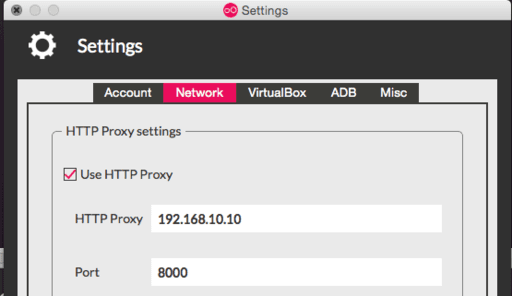Genymotion + local web server with different domains
Genymotion + local web server with different domains

If you find this post, maybe you are in trouble configuring Genymotion + local web server with some domains.
I use the combo Appcelerator Titanium + Genymotion to develop Android Apps and I use a Mac local web server with Laravel Homestead (Vagrant) which has more than one domain configured. This becomes a knightmare if you don't know how to config this environment, so follow my guide to make this work.
[ Server ]
First, make sure you have Laravel Homestead or Vagrant machine correctly installed and running (important). Probably you have some projects configured in the same machine. For example, you can go to your project typing in the browser http://myapp1.dev or http://myapp2.dev. Here is a /etc/hosts example file:
##
# Host Database
#
# localhost is used to configure the loopback interface
# when the system is booting. Do not change this entry.
##
127.0.0.1 localhost
255.255.255.255 broadcasthost
::1 localhost
192.168.10.10 myapp1.dev
192.168.10.10 myapp2.dev
192.168.10.10 myapp3.dev
### /etc/hosts in my current OSX
As you can see, my server IP is 192.168.10.10
[ Genymotion ]
Surely is configured, but you need to change the proxy settings as the next capture:

The problem is that you have some domains and Genymotion don't know what's the domain you want to reach, so we need to modify the file hosts inside the Android image. To do this, first run the Android OS you want. Then type the next:
cd /Applications/Genymotion.app/Contents/MacOS/tools
./adb remount
./adb push /etc/hosts /system/etc/hosts
With this instructions, you copy the current Mac hosts file to Android and now Android knows where to go when you make a request from your code. Finally, you can make the request on your code to the domain you need as the example below:
{
"global": {},
"env:development": {
"api": "http://myapp2.dev/api/"
},
"env:test": {},
"env:production": {
},
"os:android": {},
"os:ios": {},
"os:mobileweb": {},
"os:windows": {},
"dependencies": {
}
}
### config.json on Appcelerator
Some useful commands on Appcelerator:
Enable Genymotion typing: ti config genymotion.enabled true
Your current Android setup: ti info -t android
Happy coding!